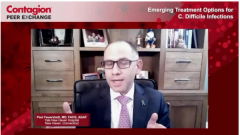
Recurrent C. Difficile
A discussion regarding the increasing frequency of C. difficile recurrence and its effects on patients and the healthcare system.
Episodes in this series

Peter L. Salgo, MD: Let’s change gears a little. We’ve been talking about community-onset Clostridioides difficile [CDI], and we’re talking about in-hospital C diff. But there’s another syndrome entirely, which is recurrent C diff. How do you define that, and what does that really mean, Joe?
Joseph Reilly, BS, PharmD, BCGP: With recurrent C diff, if you think about it, the nature of the disease is that about 1 of 4 or 1 of 5 patients who with C diff wind up getting it back within 30 or 60 days of being treated initially. We have patients who get recurrent disease again and again. If we saw 100 patients with C diff and we treated them all successfully, about 25 patients would come back with their first recurrence. If we treated those 25 successfully, about 40% of those patients would come back with their second recurrence. And if we treated those patients successfully, about 60% would come back for their third recurrence. So for every 100 patients we treat, you wind up treating over 140, which is the nature of the beast. That’s assuming that there’s no mortality.
Peter L. Salgo, MD: Holy smokes. That’s a nasty nature. We know this, and we see this. But it’s certainly something to contemplate. This disease just hangs in there.
Thomas Lodise, PharmD, PhD: Dr. Salgo, before we go on I want to say 1 thing. We mentioned some of the risk factors, and we keep on talking about antibiotics, so it’s important to remind our audience that not all antibiotics are treated equally. Time at risk, as Dale said, is a major risk factor. In the community setting, even going to the dentist could put you at risk for CDI. But being in the hospital, the longer you are, the greater your risk is.
When we think about antibiotics, the antibiotics we use most—fluoroquinolones, third-generation cephalosporins—are the drugs listed at the top of our guidelines that actually have a greater risk for selecting for a CDI infection relative to other drugs. I think about piperacillin-tazobactam, a drug that we use frequently, we always think about the beta lactamase inhibitors having a lower risk, but they still carry a great risk.
Teena talked a lot about stewardship. One thing I would say with antibiotics is that every day matters. Even 1 dose of an antibiotic can put a patient at a greater risk for CDI relative to no antibiotics. That risk increases substantially after 3 days of antibiotics. The 1 thing we always talk about when we talk to teams—they’re like, “Let’s just keep the antibiotics on for 1 or 2 more days. Let’s just be certain.”
In a hospital—Dale, if we think about our VA [Edward Hines Jr Veterans Affairs Hospital] patients, 70, 80 years old, high risk of mortality, high risk of morbidity and recurrences—often the worst thing you can do in a lot of our patients is to continue them on an antibiotic without an indication. Because that risk of CDI persists in that patient for at least 3 months. Again, the risk is great as you know during the first 14 days or 30 days, but even so, if you look at some of the better data, they carried a heightened risk of developing a CDI infection for 90 days.
We talk about stewardship, and the 1 thing we always do in our institution [Albany College of Pharmacy and Health Sciences] is drive home messages to get people off antibiotics, get them off the broad spectrum ones. We play up CDI, and Teena highlighted all morbidity and mortality associated with the disease.
Peter L. Salgo, MD: Before we change gears, I want to talk about the effect of recurrent CDI on a patient’s life. It’s 1 thing to have a terrible diarrheal disease and somehow or other you get through it and we can fix it. Then you come back; the story of recurrent diarrheal illnesses is terrible. How does it affect a person? Paul, if you could, how does that affect the entire health care resource in this country? This is a significant illness.
Paul Feuerstadt, MD, FACG, AGAF: It’s very significant. The burden of this disease is quite tremendous. We are seeing patients like this frequently. Not only the physical manifestations—the abdominal cramps, the diarrhea, the dehydration, potential syncope as a result of the frequency of the loose stools—but also the psychological effects, the adaptation or relational; the productivity effects. Patients look you in the eye, and they say, “I can’t go to work, I still can’t go to work.”
What we did was we set up a study in which patients with active C difficile—and patients with a distant history of C difficile—simply filled out a survey. We looked at 350 individuals. One-third of them had active infections; two-thirds of them had a history of infection; and across the board [there was] psychological impact, adaptational, relational, and physical. Clinical symptomatology and productivity were impacted greater than 50%, both active infections and also with a distant history.
One of the concepts that is very important is to acknowledge for patients is that this is real and that what they’re going through is not just them. I had a patient just today who contacted me for a third opinion and I immediately said, “Look, I’m here to help you, and I’m going to help you get better from C difficile.” And 30 seconds into the conversation she started crying. That was impactful. I said to her immediately, “It’s OK. You’re not alone. I see quite a few people in a similar circumstance. People feel stressed about this. They have post-traumatic stress disorder; they feel anxiety or depression. Sometimes they feel like they can’t be the person they were before. Educating ourselves as clinicians about this disease, both the physical manifestations and the emotional manifestations, will make all of us better clinicians and better equipped to approach these individuals and help them get better physically and emotionally.
Peter L. Salgo, MD: Right. To get to that point, though, you’ve got to make the diagnosis. Let’s take a look really quickly.
Teena Chopra, MD, MPH: I just want to make 1 point about these older individuals and recurrent-disease and long-term care settings. You talked about the impact of recurrent disease in older adults who are residing in long-term-care settings. When they keep getting admitted to acute hospitals with recurrent C diff, they also develop coinfections within MDROs [multidrug-resistant organisms]. The downstream effects of being admitted to the hospital are huge on the health care system.
Peter L. Salgo, MD: Sure.
Teena Chopra, MD, MPH: It is even worse for these older individuals.
Peter L. Salgo, MD: Right. It’s a disease we don’t have a good enough handle on, at least not yet.
Peter L. Salgo, MD: If you enjoyed this content, you should subscribe. We have an e-newsletter, and you can receive upcoming Peer Exchanges and other great content in your in-box—that’s right, electronically. I’ll see you next time. I’m Dr Peter Salgo. Thanks again for watching.
Newsletter
Stay ahead of emerging infectious disease threats with expert insights and breaking research. Subscribe now to get updates delivered straight to your inbox.


















































































































































































































































































































































